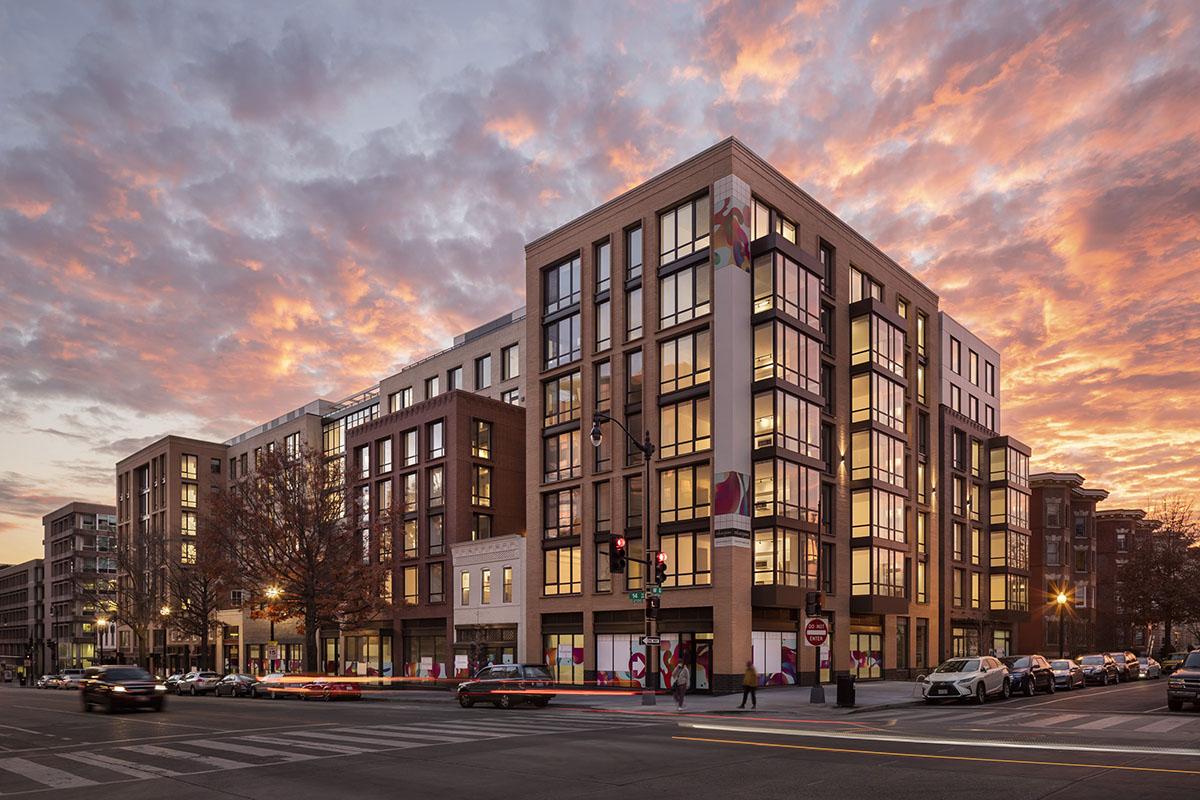There’s an adage that Professor of Architecture Matthew Bell, FAIA shares with his students about the mark of a successful design project: if you did your job right, it will feel like the building has always been there.
So, it’s no surprise that the latest project by two of Bell’s former students—Jeanine Muller and Austin Raimond—looks right at home in its eclectic U Street neighborhood. Collection 14, a mixed-use commercial and residential building in the heart of Washington, D.C., is the work of a powerhouse team at national design firm Perkins Eastman that includes Muller, Raimond, Matthew Miller (B.S. ARCH '12, M. ARCH '14) and Bell, a principal at the firm. Last month, it earned the team a 2022 Charter Award from the Congress for the New Urbanism (CNU) for excellence in urban design, one of the most prestigious design awards in the country.
What makes Collection 14 stand out is that, for the most part, it doesn’t. Spanning almost a full block of 14th street, it’s an encapsulation of history, place and architectural value not often seen in new developments across the city, blending seamlessly into its urban fabric.
“We are always looking at the whole context around us, in terms of the other buildings in the area, existing assets and history, to ensure that the project will enhance the rich identity of the neighborhood,” said Muller. “It’s something we learned in school, and it’s reinforced in practice with every project.”
Collective 14 is a significant departure from the original client ask, design plans for two residential buildings along the same stretch of 14th Street between W and V Streets in Northwest Washington. But the existing collection of early-20th century historic buildings sandwiched between the sites presented an opportunity to create a cohesive stitching of building facades, program, and function evocative of its place in the artsy neighborhood.
“I think it was exciting proposition,” said Raimond, who credits colleague and Adjunct Professor Tim Bertschinger for making the case to the client. “If you can tell a client that just by investing a little bit more and broadening the scope, the return on the investment could greatly increase the success of the building.”
Commandeering the bulk of the block, including an unsightly gas station, gave the team the opportunity to bring an asset to the community that embraces both its arts district roots and evolving neighborhood needs. Rather than tear down the existing early commercial buildings, the team brought them magically to life, leaning on extensive historic research to recapture the original detail of the early 20th century brick facades. Weaving the existing structures into the larger project required not just research but clever engineering, with needle beams floating the buildings in place over an underground parking garage below.
“The historic preservation, to me, was the most exciting part of the project,” said Muller. “I feel like we really learned from our research of the area and that informed the design. It creates a product that fits into its environment and brings a layer of richness as you walk up and down the street.”
The new structures of Collection 14 physically and conceptionally embrace this history, enveloping the original buildings through a series of industrial-inspired vertical massing evocative of the area’s commercial and light industrial past. Working with the site topography and surrounding urban fabric, the project strategically activates three conditions—14th, W and V Streets—by matching the size and feel of the surrounding buildings on each street. Along the frontage of 14th street, the team created a rhythm of different building heights that’s both interesting to look at and contextually functional.
“It’s not just a building trying to do one thing,” said Raimond. “It’s living up to the expectations of three types of neighbors.”
 The CNU Charter Awards are considered the gold-standard for urban design excellence, recognizing achievements in architectural, landscape and urban design and planning worldwide. This year’s awards, the first in-person ceremony in two years, was decidedly people-focused, emphasized projects that promote togetherness and inclusion.
The CNU Charter Awards are considered the gold-standard for urban design excellence, recognizing achievements in architectural, landscape and urban design and planning worldwide. This year’s awards, the first in-person ceremony in two years, was decidedly people-focused, emphasized projects that promote togetherness and inclusion.
“It is very gratifying to me to work professionally with such talented graduates of our program at Maryland and see them rise to the occasion in a project with big challenges and high levels of complexity,” said Bell. “The result speaks well to their passion for design, dedication to the task and ability to make real many of the values that the school and Perkins Eastman both espouse.”
For Muller and Raimond, the accolade is an honor, but so was the project itself, working side-by-side with each other, their former professor, and the mind hive of their design team. Both 2016 graduates from the M.ARCH program, they also worked closely in school and benefited from Bell’s expertise as a seasoned urbanist and instructor. Their professional collaboration, they said, is a natural continuation, boosted with the perspectives and experience of the rest of their team.
“There’s a comfort in starting with this pedagogical unity and then broadening that and encapsulating the rest of the team, and I think the project was really guided through that lens,” said Muller.


